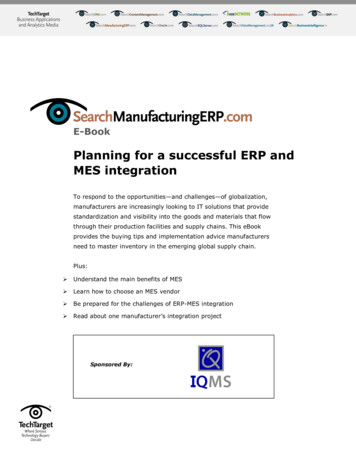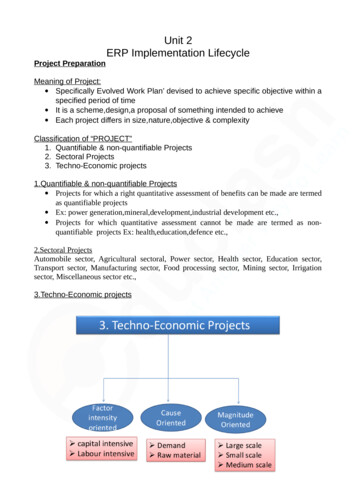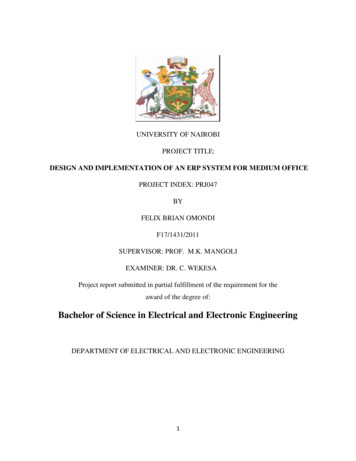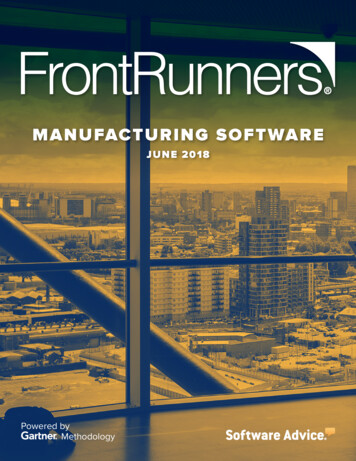
Transcription
E-BookPlanning for a successful ERP andMES integrationTo respond to the opportunities—and challenges—of globalization,manufacturers are increasingly looking to IT solutions that providestandardization and visibility into the goods and materials that flowthrough their production facilities and supply chains. This eBookprovides the buying tips and implementation advice manufacturersneed to master inventory in the emerging global supply chain.Plus: Understand the main benefits of MES Learn how to choose an MES vendor Be prepared for the challenges of ERP-MES integration Read about one manufacturer’s integration projectSponsored By:
SearchManufacturingERP.com E-BookPlanning for a successful ERP and MES integrationE-BookPlanning for a successful ERP andMES integrationTable of ContentsManufacturing execution system (MES) FAQEvaluating your need for an MES upgradeIntroduction to MES integrationManufacturing execution systems and ERP integration: A happymanufacturing marriage?Resources from IQMSSponsored By:Page 2 of 15
SearchManufacturingERP.com E-BookPlanning for a successful ERP and MES integrationManufacturing execution system (MES) FAQBy Todd R. Weiss, SearchManufacturingERP.com contributorManufacturing execution system (MES) is an incredibly complex, large and variedapplication that controls your company's manufacturing lifeblood. There is no cookie cutterMES software; each system must be built and customized for a specific application. ThisMES FAQ will help you select the best MES solution for your company's needs.What does MES software do?MES allows a company to track and monitor just about every aspect of its manufacturingprocesses in its factories, from ingredients measurement to output to labor to productionreports, while tying it all together for detailed analysis of each process. The MES softwarecan be tied into other reporting systems, including enterprise resource planning (ERP) andbusiness process management (BPM) applications to give companies a deep overall view ofits production capabilities.Can MES software fit every manufacturer?MES software is very complex and varied and must be custom-configured for specificmanufacturing situations. An MES software package for an electronics maker would not bethe same for a canned food processing plant. The applications must be built and customizedfor the specific manufacturing steps needed inside a plant through add-ons, custom codeand layered applications, depending on the requirements and vendors involved.What are some of the chief benefits of using MES for a manufacturer?Cost-savings can be directly seen through the monitoring of every step in the manufacturingcycle, from the tracking and delivery of raw materials to the progress of the products all theway through to final packaging. Companies can measure every process to find new ways tobring in process improvements that can save time, money and raw materials duringmanufacturing, as well as conduct detailed analyses to find increased productivity.Sponsored By:Page 3 of 15
SearchManufacturingERP.com E-BookPlanning for a successful ERP and MES integrationHow do you find the right MES software vendor?Start by talking with industry analysts to get their views and read as much as you can onMES vendors, especially checking into their client lists. Find MES vendors who deal withmanufacturing businesses similar to yours and call them to find out about their real worldexperiences with the MES products they brought in and about the vendors they selected.This is an incredibly complex and large application, controlling your company's lifeblood, soif you have questions and concerns, bring them up early and get them all answered beforeyou make any buying decisions. Some MES vendors are specific to certain industries, so besure to seek those out for bids and information if they already have important insights intoyour manufacturing needs.What should I be careful about as I pursue my MES strategy?Know what you need. Know your own best-practices requirements. Know your productionhardware and equipment inside out so you can be sure that it can be monitored andcontrolled by a prospective MES vendor's products. Don't believe every claim you hear froman MES vendor. Ask them to prove their claims by checking with clients who've installedtheir applications and are seeing them work every day.Know the vendor's responsibilities to uptime, production needs, tech support, training andevery other conceivable detail before you sign a contract. Know the answer to your questionbefore you even ask the vendor, because you already did the research and know it fromevery angle. Be sure your prospective vendors value your critical business processes asmuch as their own before you put your factories and production into their hands. This is anongoing partnership with the MES vendor, not just a purchase. Make sure they'll be thereafter the sale -- in writing.Todd R. Weiss is a technology journalist and freelance writer who worked as a staff reporterfor Computerworld.com from 2000 to 2008. Follow him on Twitter @ TechManTalking.Sponsored By:Page 4 of 15
SearchManufacturingERP.com E-BookPlanning for a successful ERP and MES integrationEvaluating your need for an MES upgradeBy Edward Bassett, SearchManufacturingERP.com contributorRoughly half of the manufacturing execution system (MES) software out there was deployedin the last six years, a sign that manufacturers are finding that MES upgrades are not easy,according to interviews with analysts.MES is not easy to connect to the rest of the plant or support, and it runs on old hardwareplatforms that are no longer viable, analysts say. For example, many MES systems werewritten for DEC's VAX platform, which is no longer supported.Manufacturers opting to replace MES softwareAs more manufacturers look to standardize their MES, many are opting instead to rip andreplace the systems. Integration is far easier with most of the new MES systems that arebased on Microsoft .NET Web services technology, according to Robert Parker, an analyst atIDC Manufacturing Insights. That's making it much easier to standardize across multipleplants, one of the most important reasons for investing in the new systems, analysts andvendors said."If I'm going to have manufacturing flexibility, I need consistent systems," Parker said. "Sothe movement toward putting new MES in is less about something great about the newstuff. First and foremost, it's because I need a standard reference system running acrossthe plants."Making the case for an MES upgradeHow can an organization tell when it's time to make a change?The No. 1 sign that it's time to do something, Parker said, is realizing that there is no longerportability of products between plants because everything is kept in silos.Sponsored By:Page 6 of 15
SearchManufacturingERP.com E-BookPlanning for a successful ERP and MES integrationThe rising cost of obsolescence is another sign, according to Simon Jacobson, a researchdirector at AMR, a Gartner Inc. company. Manufacturers consider new systems when thecost of maintaining an MES on an old mainframe goes through the roof, he said.The need to make a major business change is another common motivation, according toJacobson. For example, a company might want to better align its MES with a customer,supply chain, or product supply initiative.A new MES can cost anywhere from 150,000 to 300,000 for the software license, plusone and a half to three times that amount on services, depending on the complexity and thenumber of sites involved, Jacobson said. Parker put the cost for a large plant at 150,000, athird of which is the license, two thirds being services.Implementations started this year are likely to take three to six months for a project of verylow complexity, while a highly complex project can last a couple of years, Jacobson said.Parker has seen rollouts as short as six months for a single plant, while slowerimplementations tend to take 18 months.MES integration poses some challengesNewer MES systems, while much improved, still have weaknesses. MES integration is easierthan before but can still cause problems, these analysts said.Parker said that most MES systems handle scheduling processes very well; but for productgenealogy, quality management and asset management, it's a mixed bag. What's more,MES is sometimes weak at managing the costs associated with processes. To compensate,companies sometimes buy separate quality management, product, costing, and assetmanagement packages to run in conjunction with the MES, according to Parker.Also, MES software hasn't gained many truly new functions in recent years. Many of therecent innovations have focused on visualizing the production process and performinganalytics. "That's great, but if you're not delivering any value to the customers or increasingtheir brand value, those things are ultimately rendered useless," Jacobson said.Sponsored By:Page 7 of 15
SearchManufacturingERP.com E-BookPlanning for a successful ERP and MES integrationAlthough off-the-shelf MES generally performs well, most MES is weak in plant-to-enterpriseintegration, said Julie Fraser, principal industry analyst and president of Cambashi Inc.Integration can be difficult if the MES and legacy ERP can't cope with the constantreconfiguration needed to support Six Sigma continuous-improvement initiatives, whichoften require adding fields for data capture and complex feedback loops as processeschange, Jacobson said. However, ERP vendors that also offer MES tend to have easierintegration between the two packages, according to the analysts.To ward off these MES challenges, it is important for a company's business and IT sides tocollaborate on an MES project, they said. Whoever is setting the operating strategy -- forexample, a chief product supply officer -- must be involved in major decisions along with across-functional team that brings the leaders of each manufacturing site together withmanagers of centralized IT.Sponsored By:Page 8 of 15
SearchManufacturingERP.com E-BookPlanning for a successful ERP and MES integrationIntroduction to MES integrationBy Todd R. Weiss, SearchManufacturingERP.com contributorSo what is a manufacturing execution system (MES)?MES is a complex software application that can track, monitor and manage just about everymanufacturing process, system, operation and function inside multiple facilities to providemanufacturers with critical and detailed information to run their business. MES integrationwith other software systems optimizes data management across manufacturingorganizations.MES is to a manufacturing plant what an accounting system is to a financial institution -- itsheart and soul -- containing every piece of relevant operational information from incomingraw materials to processes, the mixing of ingredients, measurements, cost-saving efforts,product changes and real time monitoring on everything happening inside a factory's walls.MES software's greatest value is also one of its most difficult challenges: It's complexity issuch that one MES system can't be all things to all manufacturers. A chemical company MESsystem, for example, will require different processes than will an automaker or a large-scalebakery. Each system must be configured and adapted for whatever a company makes.MES is often integrated with other key business IT systems, including enterprise resourceplanning (ERP) and supply chain management (SCM) to enable companies to watch over allfacets of their operations. For example, ERP warehouse management system (WMS)software tracks orders that come into the warehouse through the order managementsystem so they are filled accurately and on time.Today's MES systems come from a wide assortment of vendors including Apriso Corp.,Rockwell Automation Inc., Broner Metals Solutions Ltd., Siemens A.G. and GE Automation.Many applications today are web-based and can be used through standard web browsers forease of use and accessibility from any location. This makes them very flexible and powerfulfor users.Sponsored By:Page 9 of 15
SearchManufacturingERP.com E-BookPlanning for a successful ERP and MES integrationFor more information on MES and other manufacturing applications, contact ManufacturingEnterprise Solutions Association (MESA) International. MESA is an independent, non-profitMES organization made up of manufacturing companies, IT hardware and softwaresuppliers, system integrators, analysts and others who aim to improve business productionoperations through MES and other process improvement applications.Sponsored By:Page 10 of 15
SearchManufacturingERP.com E-BookPlanning for a successful ERP and MES integrationManufacturing execution systems and ERPintegration: A happy manufacturing marriage?By Jean Thilmany, SearchManufacturingERP.com contributorIt used to be what happened on the plant floor stayed on the plant floor.The manufacturing execution system (MES) -- a central system for managing allmanufacturing information such as resource allocation, manufacturing planning, supplychain information and quality inspection numbers -- operated as an isolated and selfcontained system.Similarly, the enterprise resource planning (ERP) system, which pulls together and storesbusiness operating information about human resources, accounting, customer relationshipmanagement and other financials, hummed along independently. Both systems have alwaysbeen critical to the manufacturing organization, but until recently, had never been linked.However, during the past five years, experts say many manufacturers have realized that bymarrying these two mammoth systems, they can create an integrated ecosystem stretchingfrom headquarters across multiple factories, warehouses, engineering centers and evensales offices. This allows them to more easily home in on all company operations and refinethem as quickly as necessary. A more holistic view of purchasing, credit, accounting, supplychain management and manufacturing planning gives them greater agility and better datato aid in decision making and forecasting -- from sales and purchases to asset utilizationand hiring and manufacturing planning.Integrating MES and ERP brings operational clarityBonset America Corp. in Browns Summit, N.C., makes heat-shrinkable film used to createlabels and safety seals for packaging. It faced the perennial problem plaguing manymanufacturers: The manufacturing side and the business side didn't talk -- they simply hadno effective way to communicate.Sponsored By:Page 11 of 15
SearchManufacturingERP.com E-BookPlanning for a successful ERP and MES integrationThe company relies on a manufacturing execution system to track raw materials. But theenterprise resource management system, which tracks other business functions, couldn'treceive that information."We just didn't have a means to automatically convert the data from the MES to the ERP,"said Rob Richardson, Bonset's information technology manager.That lack of system communication made it hard to sync business and manufacturinginformation for an overall view of company operations.So, Bonset started an MES and ERP integration project -- but first had to solve a gatingproblem.Although plant-floor employees could automatically weigh material put into the blenders,they still recorded raw materials manually. This manual input allowed Bonset to record onlyessential data. But the whole integration goal was to make as much data as possibleavailable to get an overall look at how the company was functioning. So a key step in theproject was implementing an automated data collection system. The data collectiontechnology helps track exactly which raw materials are used to produce finished goods.Integrated in tandem with the MES and ERP systems, this allows Bonset to track rawmaterials as well as finished goods.The Bonset plant and its corporate side can now calculate efficiency and better determinecosts."The biggest improvement for Bonset has been the ability to more accurately tracematerials in our system and our raw material inventory accuracy," Richardson said.It was a similar story when executives at Des Plaines, Ill.-based specialty chemicalmanufacturer UOP LLC sought a way to increase the value of its new ERP system. UOP, awholly owned subsidiary of Honeywell International Inc., teamed with Raytheon Co. todeploy an enterprise-wide IT architecture that connected the MES and business systems.Sponsored By:Page 12 of 15
SearchManufacturingERP.com E-BookPlanning for a successful ERP and MES integration"Return on an ERP investment can be increased by 50 percent by integrating it withaccurate, real-time, plant information," said Dave Mueller, former senior systems specialistat Raytheon Consulting and Systems Integration in Pittsburgh.ERP and MES software market responding to demandAs vendors have come out with offerings that ease integration and as standards-settingsbodies have also stepped in to help, interest in marrying MES and ERP has really rampedup, adds Greg Gorbach, vice president of collaborative manufacturing at the ARC Group, aBoston-based manufacturing consulting firm."For the past four of five years now, we've really seen a sharp uptick in interest in peoplelooking to integrate these business systems," Gorbach said.The case for integration is sweetened in part because of new demands for fast responsetimes in manufacturing. While both MES and ERP can give executives a detailed snapshotinto what's happening within a business at exactly one moment in time, the ERP systemreturns basically a snapshot, while the MES offers a better way for organizations to react tothe events it tracks.ERP is essentially a reporting technology, a way to store myriad information in accessibleform. But ERP simply gives an overview of company operations: what's been sold, what'sbeen ordered. In contrast, an MES shows what's happening in real time and connects thedots more quickly, so manufacturers can react and immediately see results based on whatthey've changed. The MES system can show, for instance, that product inventory is 50 but75 orders were just received, so inventory will need to be increased by 25 and the companyshould immediately start making more product. Or, if the MES system shows that orders fora particular item have increased, planners could react by ordering exact quantities of theraw ingredient needed to produce the item.ERP plays an important role, too. MES systems can feed ERP systems accurate, timelyinformation such as production levels, inventory, work-in-process status, and part and serialnumbers, for tracking purposes.Sponsored By:Page 13 of 15
SearchManufacturingERP.com E-BookPlanning for a successful ERP and MES integrationThe latter is particularly useful for companies that need to comply with stepped-upregulatory reporting to government agencies, such as those in the medical device, food andpharmaceutical realms.It's that kind of ability to react and run a more efficient operation that business leaders seekby linking the systems, Gorbach said."Executives wanted to have visibility into the plant floor system to better answer questionsfrom customers," he said. "Even during the manufacturing process, customers would wantto know, where are you with the quality of my product?"ERP and MES integration still challenging, but easier nowIntegration is less a headache than in the past, due to new features in many of thetechnology offerings, but some companies still need to bring in third-party integrators.Others need to add extra software to aid integration, Gorbach said. Bonset's data collectiontechnology implementation is just one example of additional capabilities that might supportan ERP and MES integration project. Though the challenges of marrying the two systems arefewer than in early integration days, they still remain, analysts concur.But the industry is responding to ease MES and ERP integration pains. Today's vendors offereasy-to-implement integration options, the analysts say. Also, the ISA standard SP95addresses factory ERP communications, which helps ensure systems will operateharmoniously, said ISA's Chip Lee, director of standards, publishing. The standard helpsmake integration consistent across vendor offerings and companies.And that kind of consistency helps keep these systems on speaking terms, exchanging vitalinformation and helping manufacturers respond to new demands more efficiently than everbefore.Jean Thilmany is a freelance writer.Sponsored By:Page 14 of 15
SearchManufacturingERP.com E-BookPlanning for a successful ERP and MES integrationResources from IQMSEnterpriseIQ Industry Specific ERP and Manufacturing Software SolutionsManufacturing ERP and Supply Chain Software Solution from IQMSEnterpriseIQ Manufacturing Software SolutionAbout IQMSIQMS offers the innovative EnterpriseIQ ERP software for the manufacturing industry.Designed as a scalable, single source solution with multiple location, language and currencycapabilities, EnterpriseIQ is the best industry specific solution available.Sponsored By:Page 15 of 15
Integration can be difficult if the MES and legacy ERP can't cope with the constant reconfiguration needed to support Six Sigma continuous-improvement initiatives, which often require adding fields for data capture and complex feedback loops as processes change, Jacobson said. However, ERP vendors that also offer MES tend to have easier











